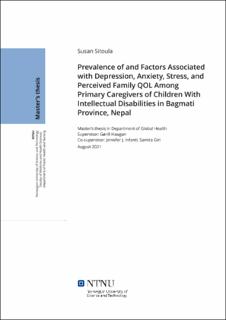| dc.description.abstract | Introduction: Ill mental health and low quality of life among caregivers of children with intellectual disabilities have been associated with lack of financial stability, the severity of disability of the child, and inadequate health care facilities, amongst other factors. While increased stress, anxiety, and depression among such caregivers is evident globally, it is higher in low-income countries (LICs) because of lack of government relief for caregivers, life stressors related to impoverishment, stigma associated with disability and mental health, etc. Data on caregivers and their health, in general, is scarce in Nepal. We aimed to estimate the prevalence of anxiety, depression, stress, and perceived family quality of life (FQOL) in a population of primary caregivers of children with intellectual disability (CWID) in urban and rural areas of Province 3 in Nepal.
Methods: A total of 215 primary caregivers of CWID, who send their children to daycare centers, participated in this cross-sectional study. Socio-demographic and health-related data were collected through phone interviews. The health-related data included the prevalence of symptoms of anxiety and depression, assessed using the Hopkins Symptoms Checklist-25 (HSCL-25). The caregivers’ level of stress and satisfaction of their quality of life were calculated using the Perceived Stress Scale (PSS) and Beach Centre Family Quality of Life (FQOL) scale, respectively. A correlation matrix was tabulated using Cramer’s V to estimate the associations between mental distress and several covariates such as family income, severity of disability, employment, and more.
Results: The prevalence of anxiety and depression was 6% (N=13) and 5.6% (N=12), respectively. 98.1% (N=211) of the caregivers experienced stress, and 3.7% (N=8) reported having less than acceptable family life satisfaction. Strong associations were not observed between the dependent variables and covariates. Anxiety and depression had associations with the residency of caregivers (rural or urban), employment status, family income, and the caregivers’ health conditions. Association between FQOL and stress of caregivers was also observed while there was no association between FQOL and stress with any covariates.
Conclusion: The findings suggest low anxiety and depression, high levels of stress, and satisfaction with their FQOL among the caregivers. Given that associations between FQOL and perceived stress were observed, prevalence of stress and broader impacts of mental illness should be dealt with targeted interventions. A larger study with caregivers of CWID who do not attend schools may be warranted to capture prevalences in a population more representative of the entire country. Additionally, it seems important to explore the factors that seem to be protective against anxiety and depression despite stress in this particular population.
Keywords: caregivers; mental health; depression; anxiety; stress; family quality of life | |
